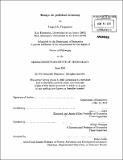| dc.contributor.advisor | Daron Acemoglu and Abhijit Banerjee. | en_US |
| dc.contributor.author | Fergusson, Leopoldo | en_US |
| dc.contributor.other | Massachusetts Institute of Technology. Dept. of Economics. | en_US |
| dc.date.accessioned | 2011-08-30T15:41:10Z | |
| dc.date.available | 2011-08-30T15:41:10Z | |
| dc.date.copyright | 2011 | en_US |
| dc.date.issued | 2011 | en_US |
| dc.identifier.uri | http://hdl.handle.net/1721.1/65486 | |
| dc.description | Thesis (Ph. D.)--Massachusetts Institute of Technology, Dept. of Economics, 2011. | en_US |
| dc.description | Cataloged from PDF version of thesis. | en_US |
| dc.description | Includes bibliographical references (p. 177-187). | en_US |
| dc.description.abstract | The chapters in this thesis tackle different questions, but share the attempt to open the "black box" of the relationship between institutions and economic outcomes. In the first chapter, I examine mass media's role in countering special interest group influence by studying county-level support for US Senate candidates from 1980 to 2002. I use the concentration of campaign contributions from Political Action Committees to proxy capture of politicians by special interests, and compare the reaction to increases in concentration by voters covered by two types of media markets - in-state and out-of-state media markets. Unlike in-state media markets, out-of-state markets focus on neighboring states' politics and elections. Consistent with the idea that citizens punish political capture exposed in the media, I find that an increase in concentration of special interest contributions reduces candidate's vote shares in in-state counties relative to the out-of-state counties, where the candidate receives less coverage. The second chapter (with Daron Acemoglu and Simon Johnson) examines the effect of population growth on violent conflict. Exploiting the international epidemiological transition starting in the 1940s, we construct an instrument for changes in population (Acemoglu and Johnson, 2007) and find that countries with higher (exogenous) increases in population experimented larger increases in social conflict. Using a simple theoretical framework, we interpret these findings as evidence that a larger population generates greater competition for resources and makes violence more likely if institutions cannot handle the higher level of disputes. The third dissertation chapter asks the following question: if property rights in land are so beneficial, why are they not adopted more widely? I propose a theory based on the idea that limited property rights over peasants' plots may be supported by elite landowners to achieve two goals. First, limited property rights reduce peasants' income from their own plots, generating a cheap labour force. Second, they force peasants to remain in the rural sector to protect their property, even if job opportunities appear in the urban sector. The theory identifies conditions under which weak property rights institutions emerge, and provides a specific mechanism for the endogenous persistence of inefficient rural institutions. | en_US |
| dc.description.statementofresponsibility | by Leopoldo Fergusson. | en_US |
| dc.format.extent | 187 p. | en_US |
| dc.language.iso | eng | en_US |
| dc.publisher | Massachusetts Institute of Technology | en_US |
| dc.rights | M.I.T. theses are protected by
copyright. They may be viewed from this source for any purpose, but
reproduction or distribution in any format is prohibited without written
permission. See provided URL for inquiries about permission. | en_US |
| dc.rights.uri | http://dspace.mit.edu/handle/1721.1/7582 | en_US |
| dc.subject | Economics. | en_US |
| dc.title | Essays on political economy | en_US |
| dc.type | Thesis | en_US |
| dc.description.degree | Ph.D. | en_US |
| dc.contributor.department | Massachusetts Institute of Technology. Department of Economics | |
| dc.identifier.oclc | 746641877 | en_US |
